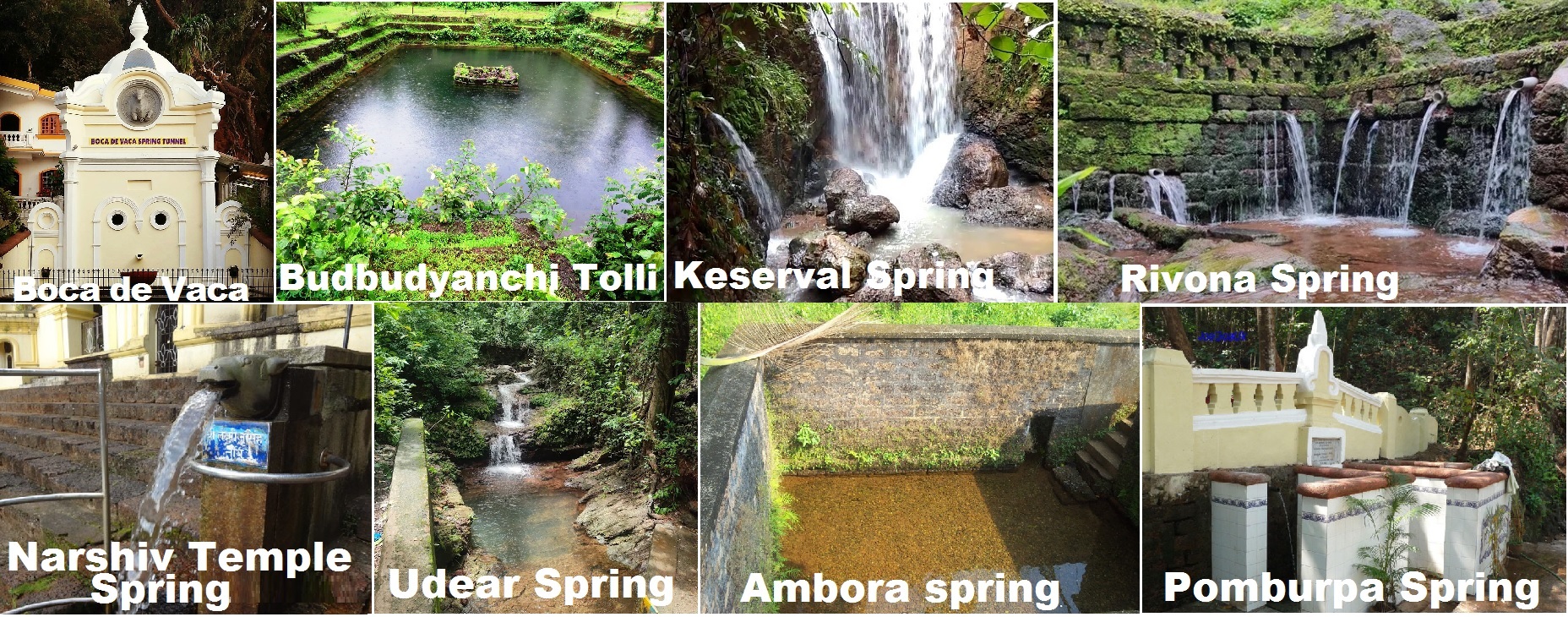
Goa’s sun-drenched shores often steal the spotlight, but true tranquillity lies tucked away in its hidden springs—nature’s wellness sanctuaries. These freshwater fountains, seamlessly blending with the region’s tropical climate, offer a refreshing contrast to the crowded beaches and noisy pool decks. Instead of following the usual tourist trail, immerse yourself in a cooler, calmer side of Goa—its pristine natural springs, perfect for escaping the heat and hustle.
Scattered across North and South Goa, hidden springs offer healing waters, scenic beauty, and cultural charm. From therapeutic mineral pools to forest retreats, they promise a refreshing escape for wellness seekers, explorers, and photographers alike.
Here is a non-exhaustive list
Camurlim, or Ambora, is a heritage-rich village in Loutolim, Salcete, South Goa, known for its perennial square-shaped Ambora spring. Locals believe the spring’s waters have medicinal value, especially for treating skin eruptions. Once a popular bathing spot, Ambora Spring is now a quiet retreat known for its natural fish spa—just dip your feet in and relax as the fish gently nibble away. It remains a peaceful spot, quietly echoing the village’s once-vibrant past.
Hidden a few metres away from the Ambulor Lake in Verna, Udear Spring is a peaceful monsoon spot, ideal for a refreshing dip amid lush greenery. Best visited during or after the rains, it dries up in summer. The atmosphere here is calm and soothing—perfect for those seeking a break from the bustle of city life. A visit to Udear Spring pairs well with a walk around Ambulor Lake or a countryside drive through the scenic Verna plateau.
Located near Shree Narshiv Temple in Veling-Mardol, this serene spring offers a peaceful escape through lush forest. Though not a major tourist spot, it is ideal for nature lovers and those seeking quiet, spiritual charm. The spring feeds the temple tank and is known for its cool, crystal-clear water. Locals not only drink from the spring but also believe it has medicinal properties. However, bathing is strictly prohibited to preserve its purity.
Nestled in Rivona village, Sanguem taluka, about 2 km from Zambaulim road, this natural spring is surrounded by lush greenery and calm. Known for its cool, clear waters and peaceful vibe, Rivona Spring offers more than refreshment—it connects visitors to nature, folklore, and ancient mysticism, making it a perfect offbeat escape into the timeless charm of rural Goa.
Rivona is known not just for its spring but also for its historical and spiritual heritage. Nearby lie the Rivona Caves, also known as Pandava Caves or Pandavache Leny—rock-cut laterite caves dating back to the 6th–7th century, believed to have housed ancient sages and reflecting early Buddhist influence.
Kesarval Spring, near the Verna plateau off the Margao highway, is a serene retreat nestled in dense greenery and tropical woodlands, just past Cortalim. The name Kesarval is derived from the Indian word for eagles, which once roosted in the forested slopes here. In earlier times, reaching the spring meant navigating a rocky, zigzag path. However, in the 1950s, steps were constructed for easier access, making it more convenient for bathers.
Kesarval Spring is well-known among locals and visitors for its believed medicinal properties, especially for treating skin and eye ailments. Traditionally, people visit annually for a rejuvenating bath in these healing waters, making it a popular natural spa. Many still believe in the curative powers of the spring, which offers a revitalising experience for the body and soul. Recognised by Goa Tourism, Kesarval Spring is most vibrant during the monsoon but slows in summer. Still, its terraced hills and forested charm make it a peaceful year-round escape.
Budbudyanchi Tolli is a sacred square laterite tank near the Gopinath Temple in Netravali, known for its unique bubbling phenomenon. Bubbles rise rhythmically from the tank’s floor, forming mesmerising patterns and creating a soft gurgling sound—believed by locals to be caused by natural gases or divine presence.
The tank, renovated during the reign of Kadamba King Jayakeshi-I, dates back to the 9th–10th century and features a central laterite pedestal. The nearby Gopinath Temple, a simple lime-coated mud structure, houses an image of Lord Krishna and showcases Shilahara-Kadamba architecture.
The area is rich in heritage, with other notable sites like the Mahalaxmi Temple, Siddeshwar Temple, Dattatray Temple, and the Kalbhairav sculpture at Vargani. On nearby hills stands the ancient Chandrasurya Temple, making Netravali a fascinating blend of natural beauty and cultural history.
In Panaji city, next to the Mahalaxmi temple, Boca de Vaca, meaning mouth of a cow in Portuguese, is a popular perennial spring known for its clear, sweet water and believed to have medicinal properties. A glass-floored tunnel with ambient music lets visitors view the flowing spring beneath their feet. Once a vital water source for the city, it remains a key attraction, especially in the evening when decorative lighting enhances its charm, particularly in the rainy season.
Located on the outskirts of Bardez taluka, Pomburpa Spring is a natural spring developed in 1915 by Augusto Mathias Pinto and Joaquim Vicente Pinto of Olaulim. Surrounded by lush areca nut plantations, the spring offers a serene, nature-filled setting.
Despite the presence of other nearby springs, Pomburpa remains a popular destination for both domestic and international tourists. Known for its therapeutic properties, the spring attracts visitors year-round, many of whom come to bathe in its waters for relief from various ailments.